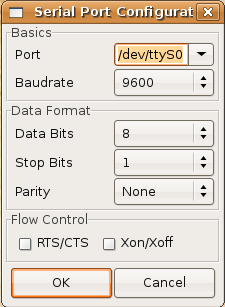PySerial — различия между версиями
Vooon (обсуждение | вклад) м (→wxTerminal.py) |
Digit (обсуждение | вклад) м |
||
| Строка 2: | Строка 2: | ||
[[Категория:HOWTO]] | [[Категория:HOWTO]] | ||
[[Категория:Python]] | [[Категория:Python]] | ||
| + | |||
| + | |||
| + | {{elec-stub}} | ||
| + | |||
Опишу что потребуется для создания гипертерминала на питоне | Опишу что потребуется для создания гипертерминала на питоне | ||
| Строка 202: | Строка 206: | ||
Пример терминала с графическим интерфейсом | Пример терминала с графическим интерфейсом | ||
требует библиотеки xWdigets и wxPython | требует библиотеки xWdigets и wxPython | ||
| − | |||
| − | |||
Версия 11:36, 4 октября 2007
Опишу что потребуется для создания гипертерминала на питоне
Что потребуется?
PyGTK это обертка над GTK поэтому нужны обе библиотеки они реализуют GUI
PySerial - библиотека работы с ком портом, работает как под Windows так и под POSIX системами
PySerial - examples
Во всех примерах линии RxD и TxD соединены.
miniterm.py
код: <source lang="python">
- !/usr/bin/env python
- -*- coding: utf-8 -*-
- Very simple serial terminal
- (C)2002-2004 Chris Liechti <cliecht@gmx.net>
- Input characters are sent directly (only LF -> CR/LF/CRLF translation is
- done), received characters are displayed as is (or as trough pythons
- repr, useful for debug purposes)
- Baudrate and echo configuartion is done through globals
import sys, os, serial, threading, getopt
EXITCHARCTER = '\x04' #ctrl+D
- first choose a platform dependant way to read single characters from the console
if os.name == 'nt':
import msvcrt
def getkey():
while 1:
if echo:
z = msvcrt.getche()
else:
z = msvcrt.getch()
if z == '\0' or z == '\xe0': #functions keys
msvcrt.getch()
else:
if z == '\r':
return '\n'
return z
elif os.name == 'posix':
import termios, sys, os
fd = sys.stdin.fileno()
old = termios.tcgetattr(fd)
new = termios.tcgetattr(fd)
new[3] = new[3] & ~termios.ICANON & ~termios.ECHO
new[6][termios.VMIN] = 1
new[6][termios.VTIME] = 0
termios.tcsetattr(fd, termios.TCSANOW, new)
s = # We'll save the characters typed and add them to the pool.
def getkey():
c = os.read(fd, 1)
#~ c = sys.stdin.read(1)
if echo: sys.stdout.write(c); sys.stdout.flush()
return c
def clenaup_console():
termios.tcsetattr(fd, termios.TCSAFLUSH, old)
sys.exitfunc = clenaup_console #terminal modes have to be restored on exit...
else:
raise "Sorry no implementation for your platform (%s) available." % sys.platform
CONVERT_CRLF = 2 CONVERT_CR = 1 CONVERT_LF = 0
def reader():
"""loop forever and copy serial->console"""
while 1:
data = s.read()
if repr_mode:
sys.stdout.write(repr(data)[1:-1])
else:
sys.stdout.write(data)
sys.stdout.flush()
def writer():
"""loop and copy console->serial until EOF character is found"""
while 1:
c = getkey()
if c == EXITCHARCTER:
break #exit app
elif c == '\n':
if convert_outgoing == CONVERT_CRLF:
s.write('\r\n') #make it a CR+LF
elif convert_outgoing == CONVERT_CR:
s.write('\r') #make it a CR
elif convert_outgoing == CONVERT_LF:
s.write('\n') #make it a LF
else:
s.write(c) #send character
print a short help message
def usage():
sys.stderr.write("""USAGE: %s [options]
Miniterm - A simple terminal program for the serial port.
options: -p, --port=PORT: port, a number, default = 0 or a device name -b, --baud=BAUD: baudrate, default 9600 -r, --rtscts: enable RTS/CTS flow control (default off) -x, --xonxoff: enable software flow control (default off) -e, --echo: enable local echo (default off) -c, --cr: do not send CR+LF, send CR only -n, --newline: do not send CR+LF, send LF only -D, --debug: debug received data (escape nonprintable chars)
""" % (sys.argv[0], ))
if __name__ == '__main__':
#initialize with defaults
port = 0
baudrate = 9600
echo = 0
convert_outgoing = CONVERT_CRLF
rtscts = 0
xonxoff = 0
repr_mode = 0
#parse command line options
try:
opts, args = getopt.getopt(sys.argv[1:],
"hp:b:rxecnD",
["help", "port=", "baud=", "rtscts", "xonxoff", "echo",
"cr", "newline", "debug"]
)
except getopt.GetoptError:
# print help information and exit:
usage()
sys.exit(2)
for o, a in opts:
if o in ("-h", "--help"): #help text
usage()
sys.exit()
elif o in ("-p", "--port"): #specified port
try:
port = int(a)
except ValueError:
port = a
elif o in ("-b", "--baud"): #specified baudrate
try:
baudrate = int(a)
except ValueError:
raise ValueError, "Baudrate must be a integer number, not %r" % a
elif o in ("-r", "--rtscts"):
rtscts = 1
elif o in ("-x", "--xonxoff"):
xonxoff = 1
elif o in ("-e", "--echo"):
echo = 1
elif o in ("-c", "--cr"):
convert_outgoing = CONVERT_CR
elif o in ("-n", "--newline"):
convert_outgoing = CONVERT_LF
elif o in ("-D", "--debug"):
repr_mode = 1
#open the port
try:
s = serial.Serial(port, baudrate, rtscts=rtscts, xonxoff=xonxoff)
except:
sys.stderr.write("Could not open port\n")
sys.exit(1)
sys.stderr.write("--- Miniterm --- type Ctrl-D to quit\n")
#start serial->console thread
r = threading.Thread(target=reader)
r.setDaemon(1)
r.start()
#and enter console->serial loop
writer()
sys.stderr.write("\n--- exit ---\n")
</source> Результат работы: <source lang="text"> vovan@ubuntu-vooon:~/scripts/python/com-wake/pyserial-2.2/examples$ python ./miniterm.py -Den -p 0 -b 115200 --- Miniterm --- type Ctrl-D to quit hheelllloo wwoorrlldd!! \n --- exit --- </source>
wxTerminal.py
Пример терминала с графическим интерфейсом требует библиотеки xWdigets и wxPython

